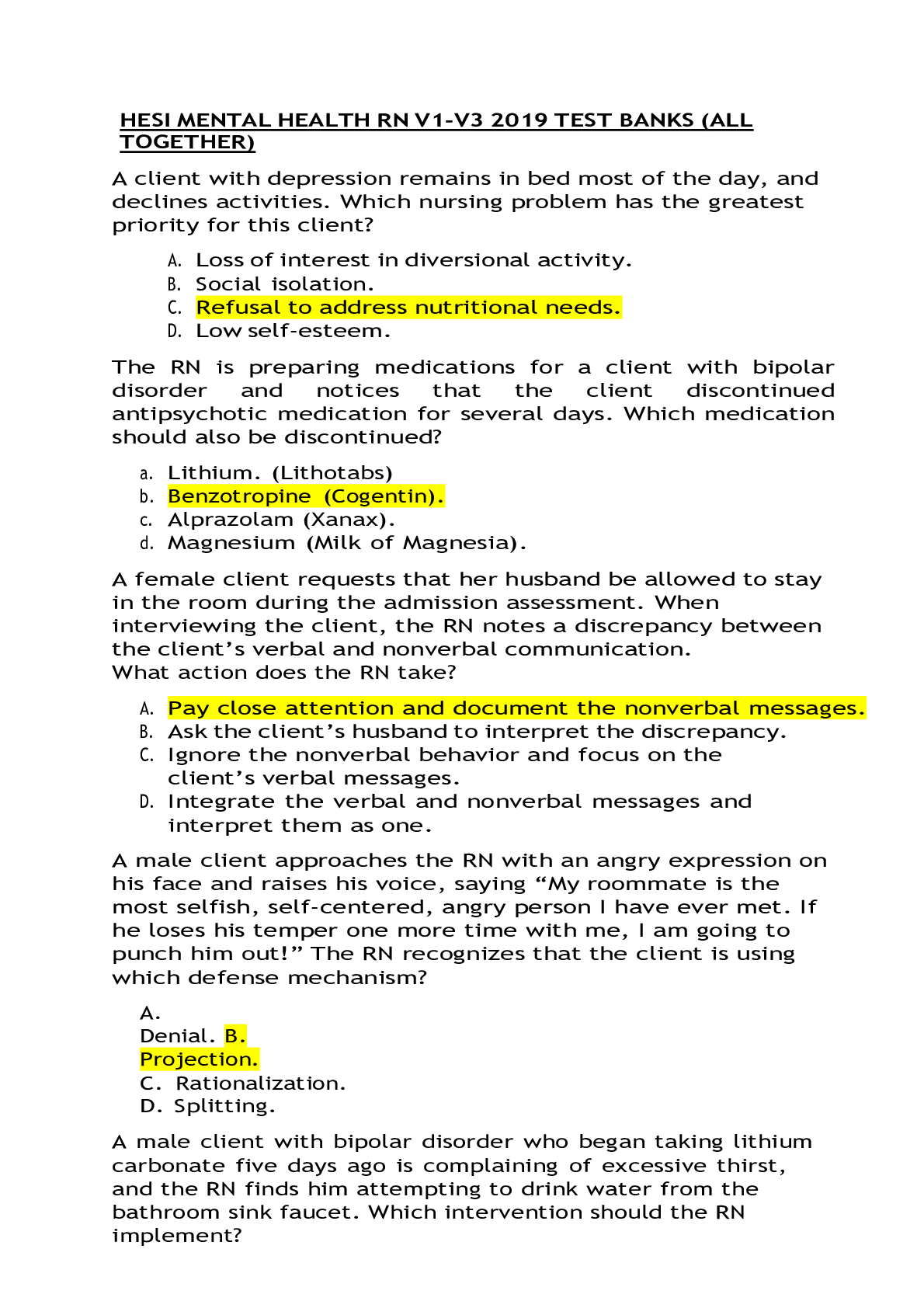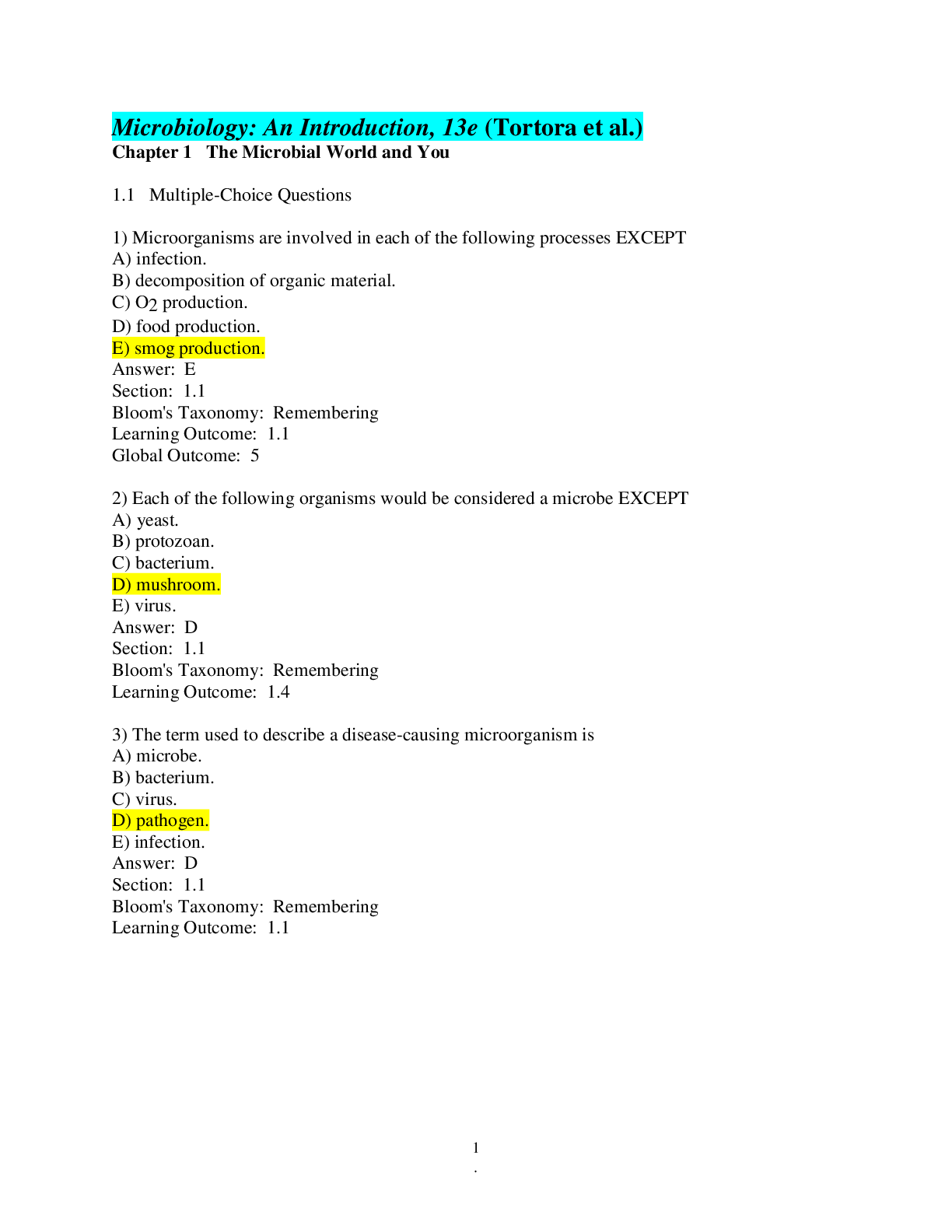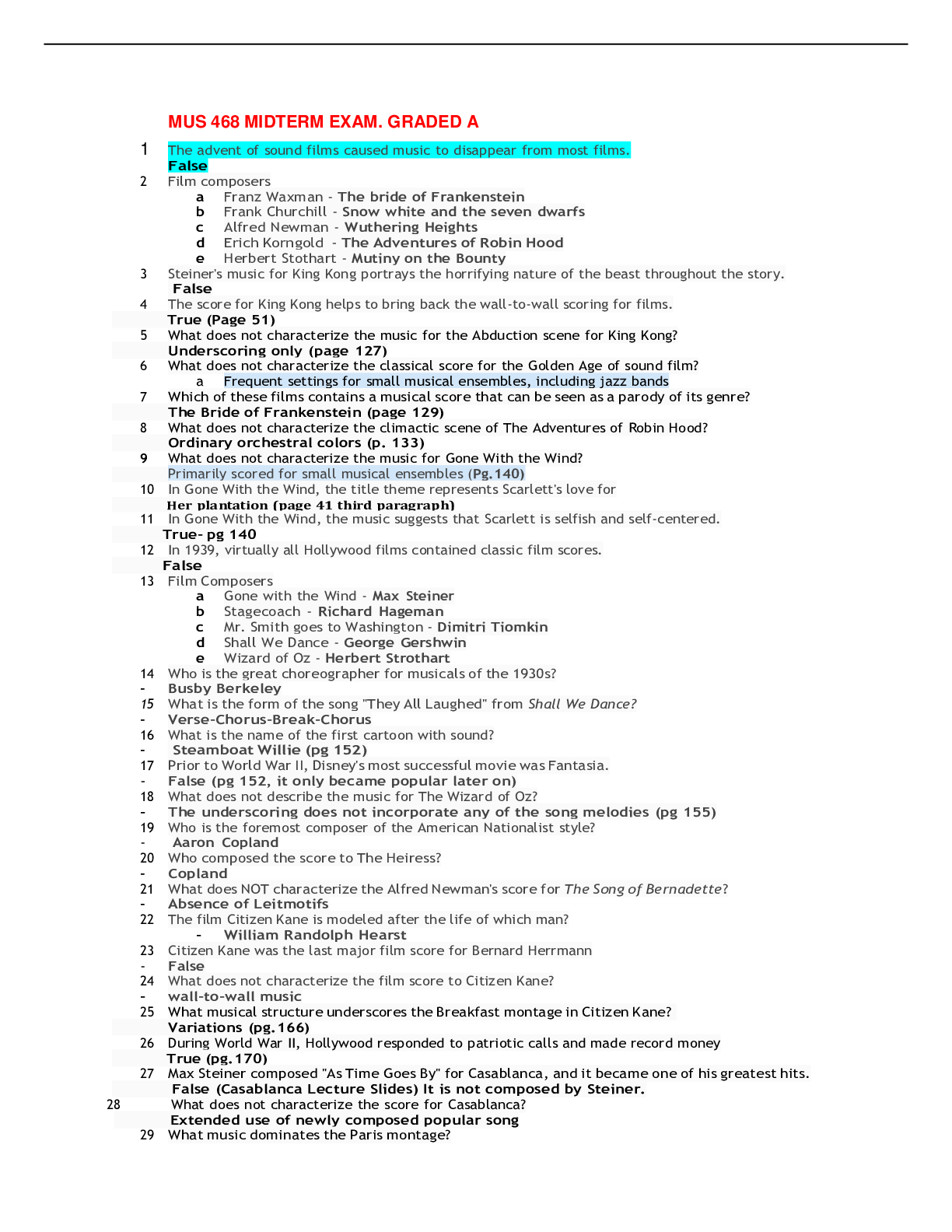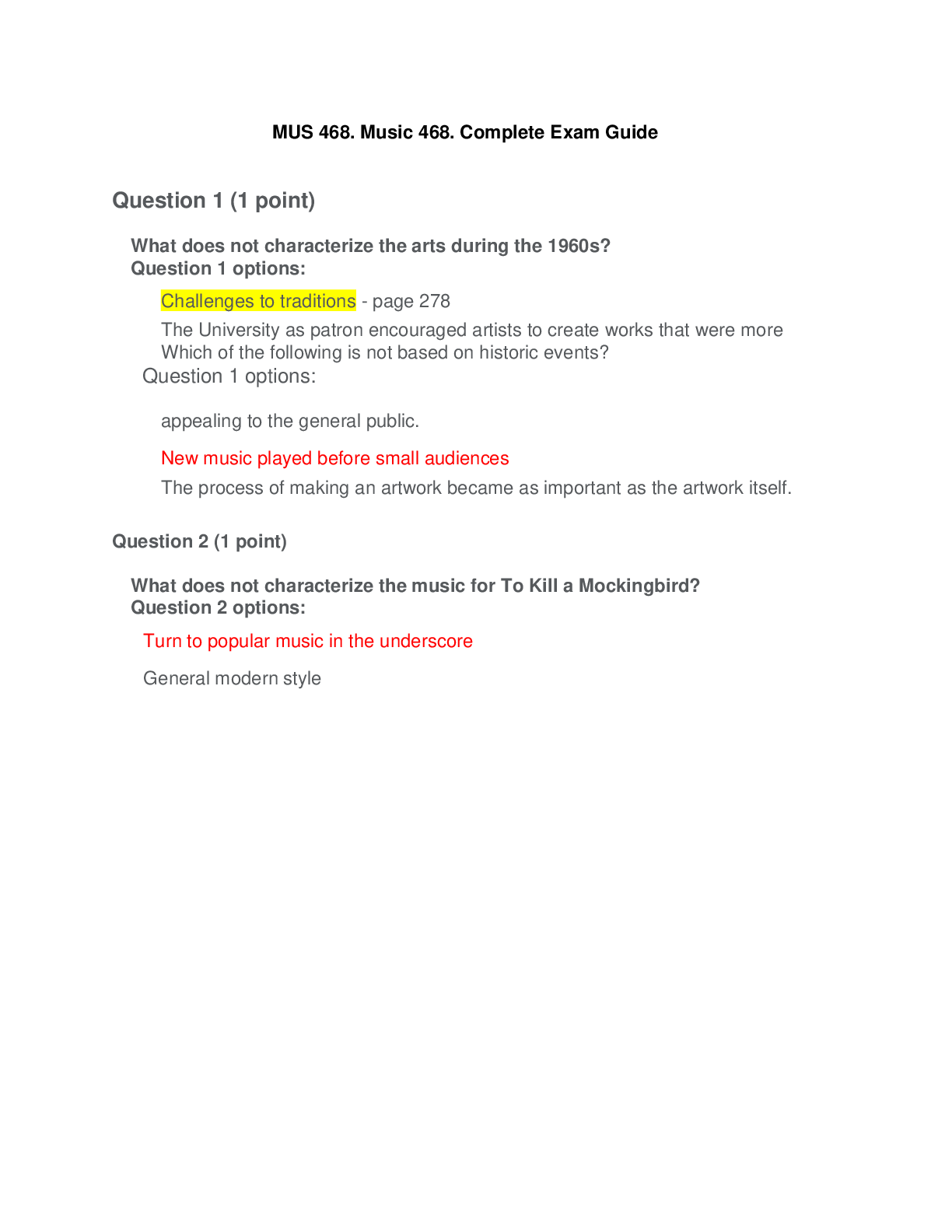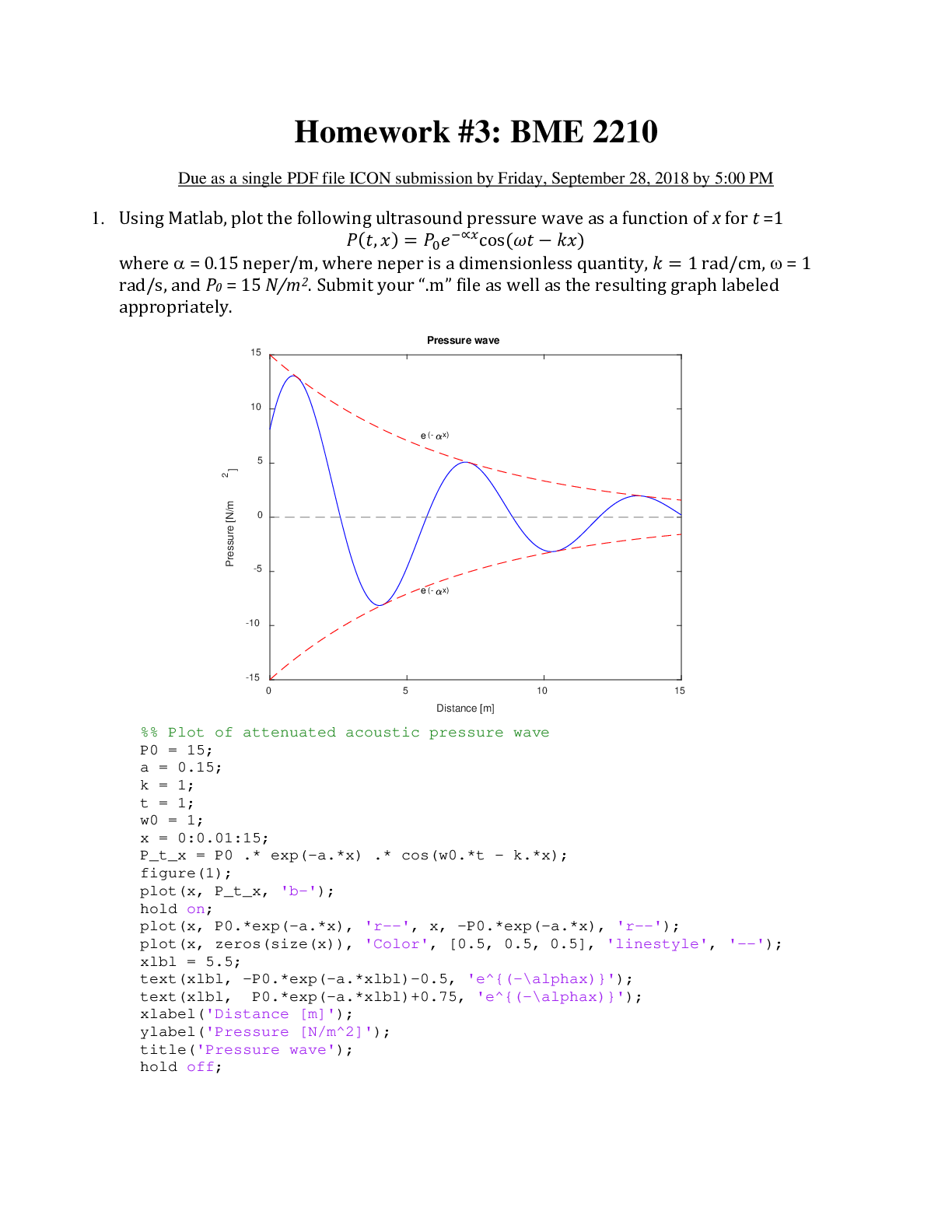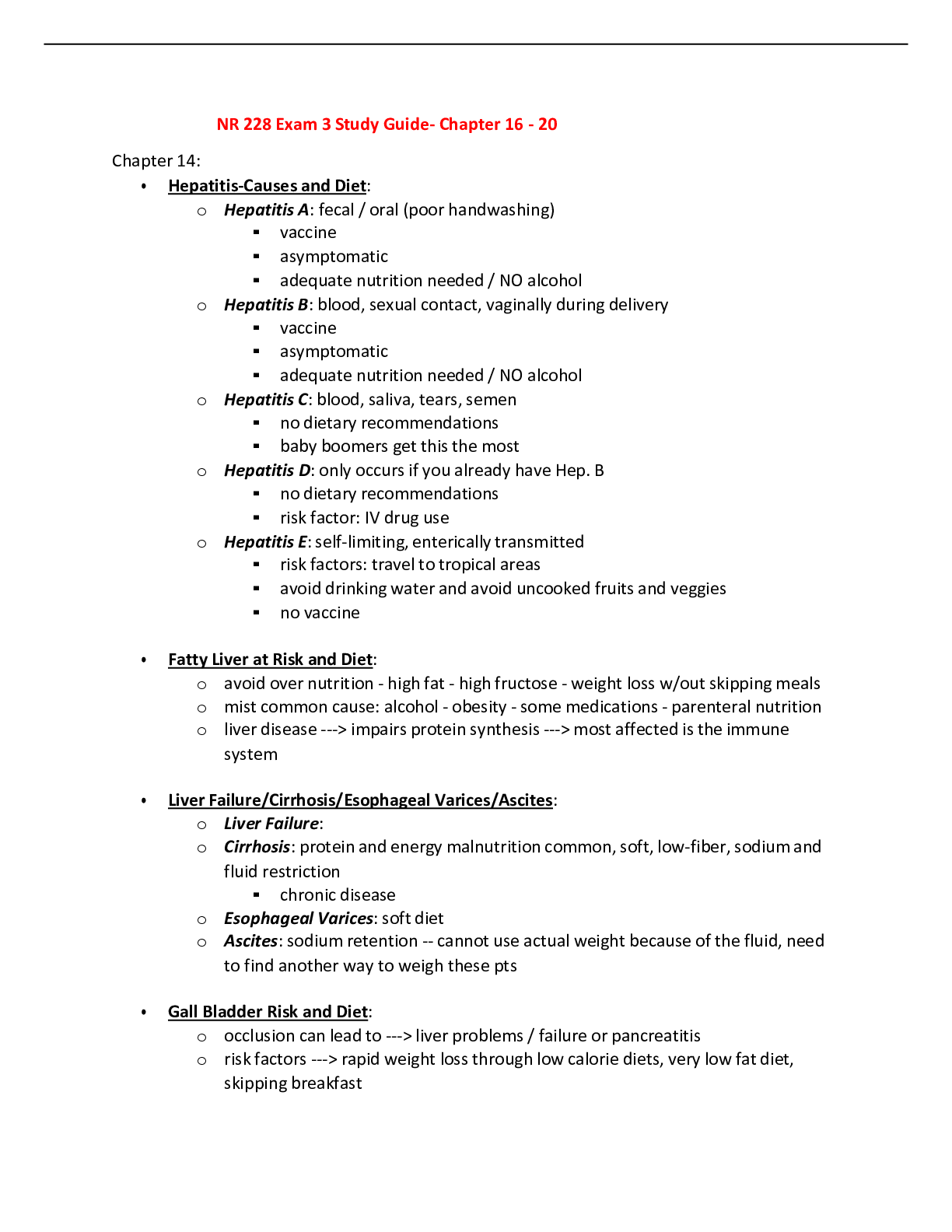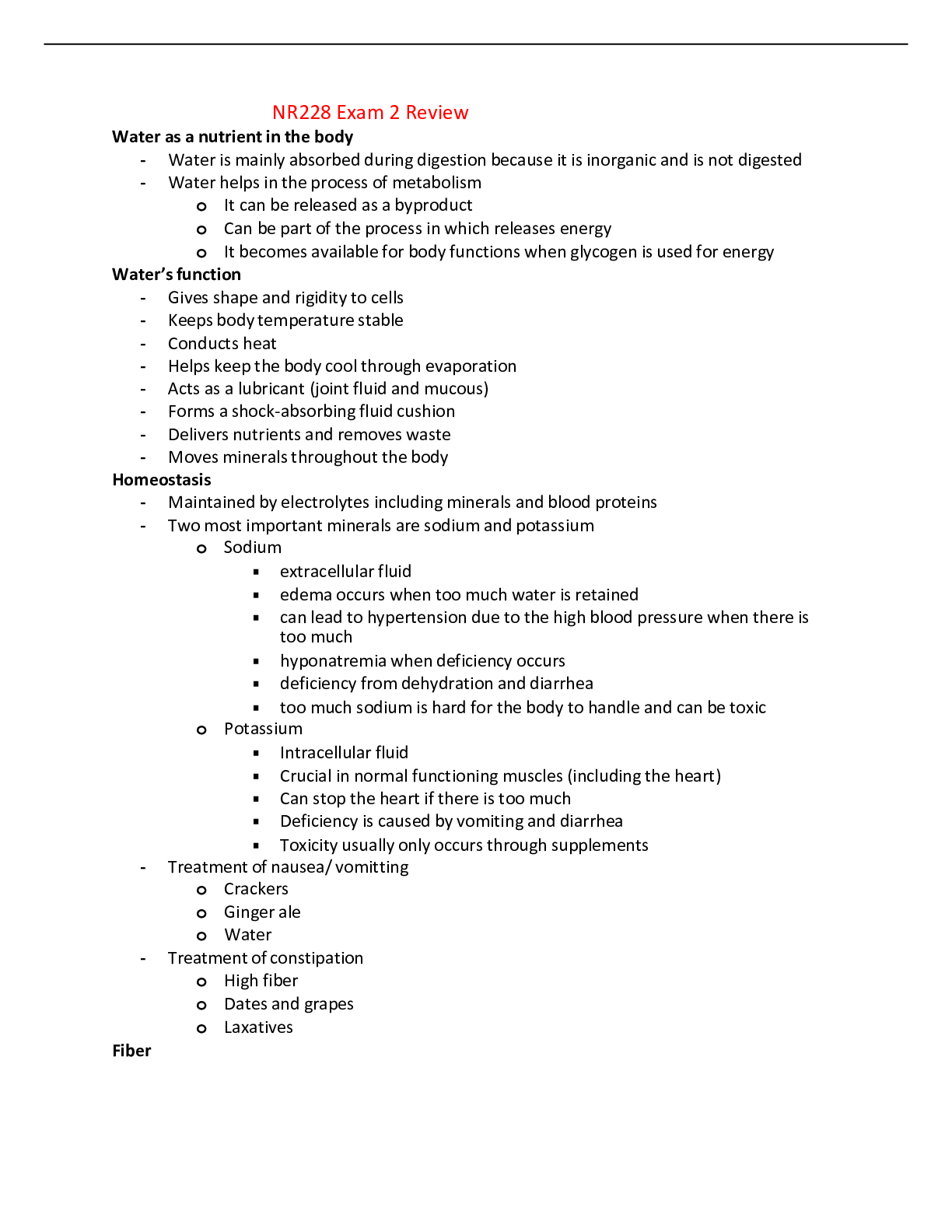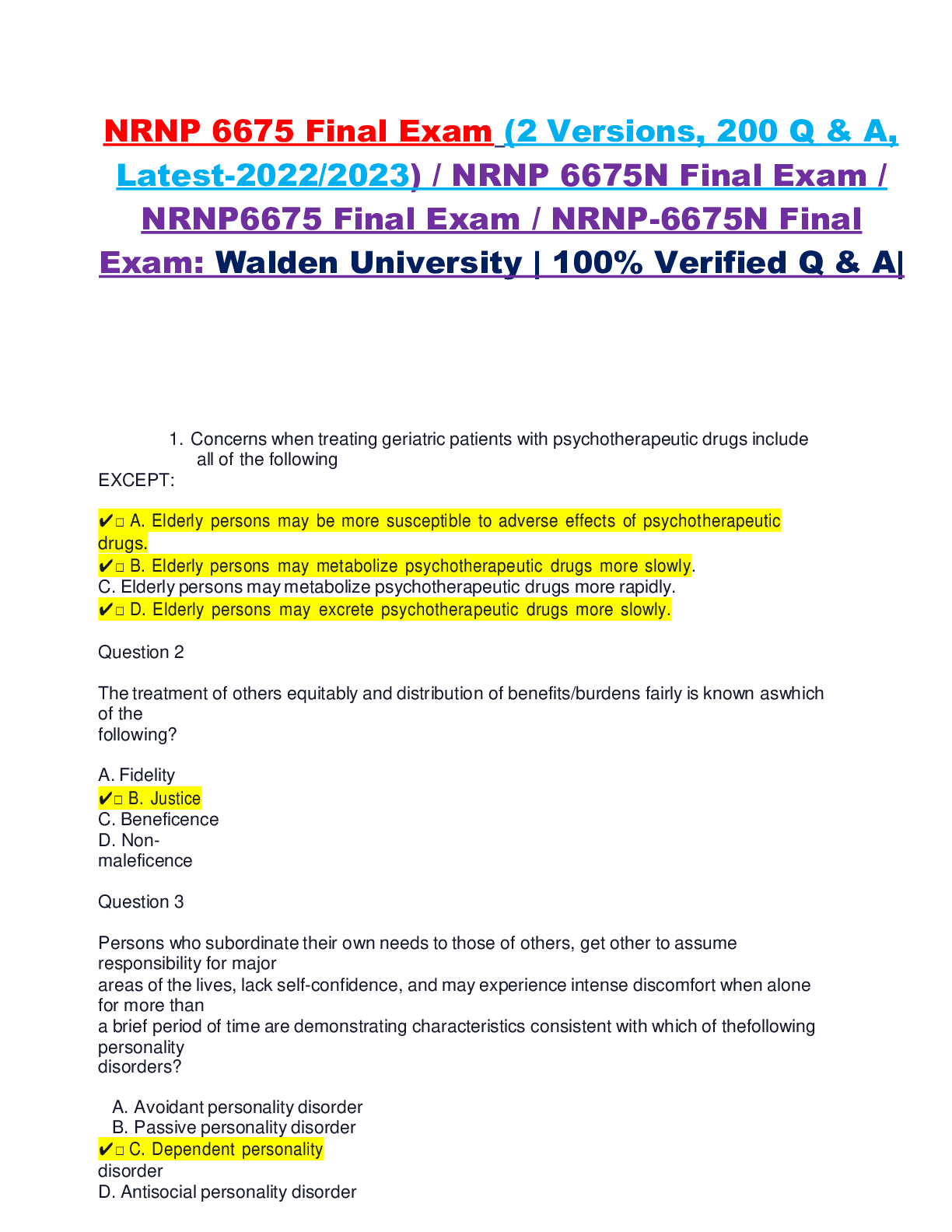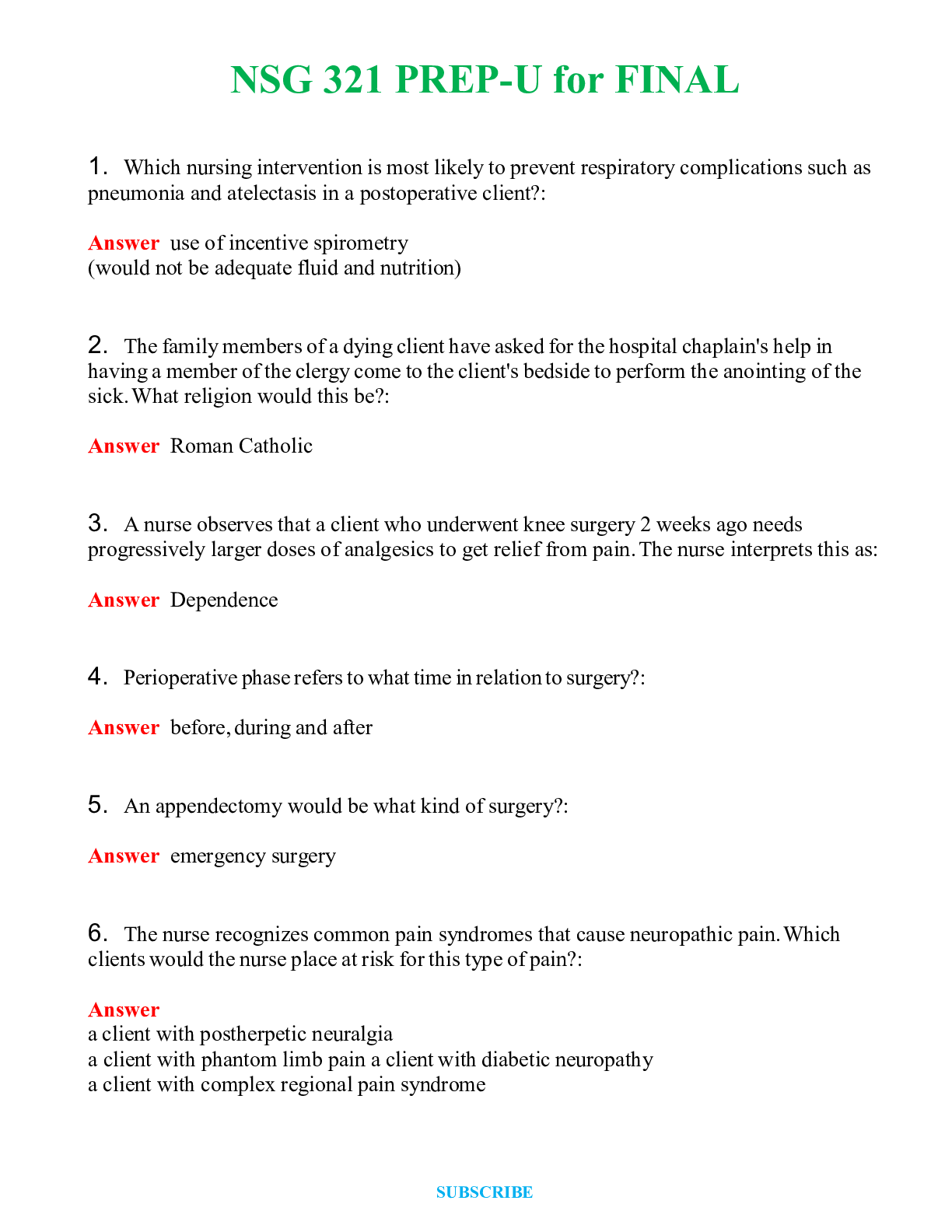Biol 238
Document Content and Description Below
27) large canals Canals that lie at right angles to the long axis of the bone and connect the blood and nerve supply of the periosteum to the central canal and medullary cavity are known as: ... Student Response Value Correct Answer Feedback 1. canaliculi 2. Volkmann's canals 3. Sharpey's fibers 4. trabeculae Score: 0.07/0.07 21. 28) Patellar ligament The patellar ligament connect the patella to the: Student Response Value Correct Answer Feedback 1. rectus femoris muscle 2. tibial tuberosity 3. calcaneus 4. fibula Score: 0.07/0.07 22. 29) rectus femoris action The rectus femoris acts to move the: Student Response Value Correct Answer Feedback 1. patella 2. tibial tuberosity 3. calcaneus 4. fibula Score: 0.07/0.07 23. 3) produce an action potential on the sarcolemma Depolarization must reach the ___ in order to produce an action potential on the sarcolemma. Student Response Value Correct Answer Feedback 1. chemically-gated Na+ channels. 2. voltage-gated Na+ channels. 3. chemically-gated K+ channels. 4. voltage gated Ca+2 channels. Score: 0.07/0.07 24. 30) autoimmune disease The autoimmune disease in which the immune system cells release chemicals which attack the joint tissues and cause severe inflammation is called: Student Response Value Correct Answer Feedback 1. gouty arthritis 2. rheumatoid arthritis 3. osteoarthritis 4. inflammatory arthritis Score: 0.07/0.07 25. 31) joint injury What is the name of the joint injury in which the bone becomes dislocated from its position in the socket of the joint? Student Response Value Correct Answer Feedback 1. sprain 2. strain 3. luxation 4. separation Score: 0.07/0.07 26. 32) mucous membranes Which type of muscle is found in layers of the mucous membranes of the respiratory and digestive systems? Student Response Value Correct Answer Feedback 1. cardiac muscle 2. skeletal muscle 3. single unit smooth muscle 4. multiunit smooth muscle Score: 0.07/0.07 27. 33) cardiac muscle Cardiac muscle cells allow an impulse to pass through the entire network of cells due to their: Student Response Value Correct Answer Feedback 1. intercalated disks 2. gap junctions 3. canaliculi 4. Sharpey's fibers Score: 0.07/0.07 28. 34) insulation and shock absorption The tissue important in insulation and shock absorption is: Student Response Value Correct Answer Feedback 1. dense irregular 2. dense regular 3. adipose 4. areolar Score: 29. 35) feedback In order for a process to be self-regulated it would use: Student Response Value Correct Answer Feedback 1. negative feedback 2. positive feedback 3. no feedback Score: 0.08/0.08 30. 36) adipose Adipose tissue located in the ___ would be used to determine nutritional condition at time of death. Student Response Value Correct Answer Feedback 1. red marrow 2. yellow marrow 3. subcutaneous 4. mesenteries Score: 0.08/0.08 31. 37) calcium supplements Calcium supplements would not be advised in the early treatment of: Student Response Value Correct Answer Feedback 1. post-menopausal osteoporosis 2. senile osteoporosis Score: 32. 38) head flexion Which muscles are the agonist and antagonist for head flexion? Student Response Value Correct Answer Feedback 1. trapezius-sternocleidomastoid 2. splenius capitus-sternocleidomastoid 3. scalenes-sternocleidomastoid 4. sternocleidomastoid-splenius capitus Score: 0.08/0.08 33. 39) head rotation Head rotation is the result of: Student Response Value Correct Answer Feedback 1. sternocleidomastoid muscles working unilaterally. 2. sternocleidomastoid muscles working bilaterally. Score: 0.08/0.08 34. 4) action potential travels to the: The action potential travels to the _____ to enter the muscle cell. Student Response Value Correct Answer Feedback 1. T-tubules 2. sarcoplasmic reticulum 3. troponin 4. tropomyosin Score: 0.08/0.08 35. 40) shoulder abduction Which muscles are the agonist and antagonist for shoulder abduction? Student Response Value Correct Answer Feedback 1. Trapezius, rhomboid major and minor 2. Deltoid, pectoralis major 3. Pectoralis major, pectoralis minor 4. Deltoid, supraspinatus 5. Latissimus dorsi, pectoralis major Score: 0.08/0.08 36. 41) rotator cuff Which muscle is NOT a member of the rotator cuff? Student Response Value Correct Answer Feedback 1. Teres major 2. supraspinatus 3. infraspinatus 4. subscapularis Score: 0.08/0.08 37. 5) blocks active sites on actin A complex composed of which molecules blocks the active sites of actin, preventing crossbridge formation? Student Response Value Correct Answer Feedback 1. tropomyosin-troponin 2. myosin-troponin 3. myosin-titin 4. tropomyosin-titin Score: 0.08/0.08 38. 6) ATP taken up At what point is ATP taken up from the sarcoplasm? Student Response Value Correct Answer Feedback 1. Reset of the myosin heads 2. Formation of actin myosin crossbridges 3. Swiveling of the myosin heads (the working stroke) 4. Detachment of myosin heads from actin. Score: 39. 7) graded contractions What type of graded contractions is seen here? Student Response Value Correct Answer Feedback 1. quantal summation 2. frequency summation Score: 0.08/0.08 41. 9) creatine phosphate Which of the following is true about creatine phosphate: Student Response Value Correct Answer Feedback 1. It is produced from ATP and creatine during periods of rest. 0% 2. It must be reconverted to ATP during muscle contraction. 3. It can provide for an additional 1 to 1.5 minutes of intense muscle contraction 4. It increases muscle strength 5. Answers 1 and 2 only. Score: 0.08/0.08 1. the distal epiphyseal plate The distal epiphyseal plate of long bones hardens at: Student Response Value Correct Answer Feedback A. 1.5 to 2 years after birth B. late teens C. early twenties D. birth Score: 0/1 2. paranasal sinuses 1 Which of these is NOT one of the paranasal sinuses? Student Response Value Correct Answer Feedback 1. frontal sinus 2. sphenoid sinus 3. maxillary sinus 4. ethmoid sinus 5. mastoid sinus Score: 1/1 3. nasal cavity The primary bone which forms the nasal cavity is the: Student Response Value Correct Answer Feedback 1. nasal bone 2. ethmoid bone 3. sphenoid bone 4. vomer bone Score: 1/1 4. os coxae The three bones of the os coxae come together at the: Student Response Value Correct Answer Feedback 1. glenoid fossa 2. pubic symphysis 3. acetabulum 4. coccyx Score: 1/1 5. symphysis pubis The symphysis pubis is composed of: Student Response Value Correct Answer Feedback A. hyaline cartilage B. fibrous connective tissue C. fibrocartilage D. areolar tissue Score: 1/1 6. The first cell in bone remodeling The cell which acts first in the process of remodeling in adult bone: Student Response Value Correct Answer Feedback A. osteoclast B. osteoblast C. osteocyte D. mesenchyme cell Score: 1/1 7. Bone characteristics 1 The component responsible for the hardness and rigidity of bone is: Student Response Value Correct Answer Feedback 1. hydroxyapatite 2. proteoglycans 3. collagen fibers 4. keratin 5. Sharpey's fibers. Score: 1/1 8. bone hormones 2 The hormone which is thought to stimulate uptake of calcium into bone tissue in children: Student Response Value Correct Answer Feedback A. calcitonin B. Vitamin D3 C. growth hormone D. estrogen E. parathyroid hormone (PTH) Score: 0/1 9. bone hormones 6 This hormone stimulates osteoclastic activity. Student Response Value Correct Answer Feedback A. calcitonin B. Vitamin D3 C. growth hormone D. estrogen E. parathyroid hormone (PTH) Score: 1/1 10. Ossification 3 The frontal bone ossifies from pre-existing model of: Student Response Value Correct Answer Feedback A. hyaline cartilage B. fibrous connective tissue C. fibrocartilage D. areolar tissue Score: 1/1 11. Osteoporosis 2 Post-menopausal osteoporosis is characterized by ___ parathyroid hormone in the blood. Student Response Value Correct Answer Feedback 1. Higher than normal 2. Lower than normal Score: 0/1 14. 15. skin cancer 1 The most agressive skin cancer is: Student Response Value Correct Answer Feedback A. malignant melanoma B. squamous cell carcinoma C. basal cell carcinoma Score: 1/1 16. skin 1 Match the letters from the diagram with their descriptions. The sebacous gland A sudoriferous gland A dermal papilla A pacinian corpuscle The hypodermis B D C A E Statement The sebacous gland A sudoriferous gland A dermal papilla A pacinian corpuscle The hypodermis Score: 17. skin 3 Non-keratinized skin is found in the: Student Response Value Correct Answer Feedback 1. Outer covering of the body. 2. Lining of the mouth. 3. Lining of the vagina. 4. All of the above except A. Score: 1/1 18. glands and receptors 1 Which of the following is important in thermoregulation? Student Response Value Correct Answer Feedback A. eccrine glands 100% B. apocrine glands 0% C. sebaceous glands 0% D. Meissner's corpuscles 0% E. Pacinian corpuscles 0% Score: 0/1 19. Epidermis 1 Match descriptions with letters in the diagram. The layer containing most glands and receptors The layer which constantly exfoliates. Its cells contain numerous keratin filaments. This layer undergoes constant mitosis. Its cells contain condensed keratin granules. Statement Response Value Correct Match The layer containing most glands and receptors D The layer which constantly exfoliates. A Its cells contain numerous keratin filaments. B This layer undergoes constant mitosis. E Its cells contain condensed keratin granules. C Score: 20. Areolar tissue 2 Match letters with descriptions. A fibroblast Reticular fiber Elastic fiber Collagen fiber Statement A fibroblast Reticular fiber Elastic fiber Collagen fiber Score: 21. cartilage 3 The least common of the following tissues is: Student Response Value Correct Answer Feedback 1. hyaline cartilage 2. fibrocartilage 3. elastic cartilage 4. dense regular connective tissue Score: 1/1 22. cell structure 2 When tissue wraps to form a tubule the ___ surface is toward the lumen. Student Response Value Correct Answer Feedback 1. apical 2. basal Score: 1/1 23. cell junctions 1 Match the junction with its description. gap junction hemidesmosome desmosome tight junctions zona adherens also known as macula adherens, these prevent cells in the epidermis and other tissues from pulling apart these connect epithelium to its basement membrane these are small junctions for attaching cells together osteocytes use this to exchange calcium ions block or partially block the transport of molecules between cells in a semipermeable membrane Statement Response Value Correct Match gap junction hemidesmosome desmosome tight junctions zona adherens Score: 0/1 24. connective tissue components 2 The component of connective tissues responsible for maintaining hydration is: Student Response Value Correct Answer Feedback 1. cells and fibers 2. proteoglycans 3. inorganic materials 4. hydroxyapatite Score: 0/1 25. Connective tissues 1 Match tissues with descriptions areolar tissue adipose tissue dense regular dense irregular reticular connective tissue elastic connective tissue B E F C A D Score: 2.5/2.5 26. feedback 2 A process which controls a parameter within a narrow range will utilize: Student Response Value Correct Answer Feedback A. Negative feedback B. Positive feedback C. Neural controls D. Hormonal Controls Score: 27. vertebral arch The portion of the vertebral arch between the spinous process and the transverse process is called the: Student Response Value Correct Answer Feedback 1. pedicle 2. lamina 3. rostrum 4. crista galli 5. cribriform plate Score: [Show More]
Last updated: 1 year ago
Preview 1 out of pages

Reviews( 0 )
Document information
Connected school, study & course
About the document
Uploaded On
Mar 09, 2021
Number of pages
Written in
Additional information
This document has been written for:
Uploaded
Mar 09, 2021
Downloads
0
Views
3

 HESI VI EXIT EXAM.png)
